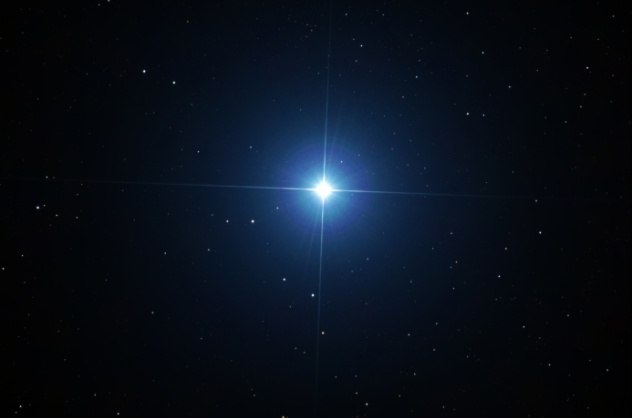 Mysteries
Mysteries  Mysteries
Mysteries  History
History 10 Surprising Stories About the Texas Rangers
 Humans
Humans 10 Philosophers Who Were Driven Mad by Their Own Theories
 Miscellaneous
Miscellaneous 10 Video-Game-Worthy Weapons and Armors from History
 Weird Stuff
Weird Stuff 10 Psychics Who Accurately Predicted Wartime Events
 The Arts
The Arts 10 Pieces of Art Inspired by a Broken Heart
 Health
Health 10 Science Fiction-Sounding New Medical Treatments
 History
History 10 Surprising Facts About the Father of Submarine Warfare
 Space
Space Ten Astonishing New Insights into Alien Worlds
 Weird Stuff
Weird Stuff 10 Bizarre Summer Solstice Rituals Still Practiced Today
 Mysteries
Mysteries Top 10 Haunting Facts About the Ghost Ship MV Alta
 History
History 10 Surprising Stories About the Texas Rangers
 Humans
Humans 10 Philosophers Who Were Driven Mad by Their Own Theories
Who's Behind Listverse?

Jamie Frater
Head Editor
Jamie founded Listverse due to an insatiable desire to share fascinating, obscure, and bizarre facts. He has been a guest speaker on numerous national radio and television stations and is a five time published author.
More About Us Miscellaneous
Miscellaneous 10 Video-Game-Worthy Weapons and Armors from History
 Weird Stuff
Weird Stuff 10 Psychics Who Accurately Predicted Wartime Events
 The Arts
The Arts 10 Pieces of Art Inspired by a Broken Heart
 Health
Health 10 Science Fiction-Sounding New Medical Treatments
 History
History 10 Surprising Facts About the Father of Submarine Warfare
 Space
Space Ten Astonishing New Insights into Alien Worlds
 Weird Stuff
Weird Stuff 10 Bizarre Summer Solstice Rituals Still Practiced Today
10 Alternatives To The Conventional Big Bang Theory
Terry Pratchett described the conventional view of the creation of the universe like this: “In the beginning there was nothing, which exploded.” The current mainstream view of cosmology is of an expanding universe that originated from the big bang, which is well-supported by evidence in the form of cosmic background radiation and the shift of distant light toward the red end of the spectrum, suggesting that the universe is steadily expanding.
However, not everyone is convinced. Over the years, various alternative and varying views of cosmology have been presented. Some are interesting speculations that remain sadly unverifiable with our current evidence or technology. Others are misguided flights of fantasy, rebelling against the insufferable way that the universe appears to defy human notions of common sense.
10 Steady State
According to a recently recovered manuscript by Albert Einstein, the great scientist paid credence to British astrophysicist Fred Hoyle’s theory that space could continue expanding indefinitely while maintaining a consistent density if new matter was constantly introduced by spontaneous generation. For decades, many considered Hoyle a crank, but the document suggests that Einstein at least gave the ideas serious consideration.
The steady state theory was proposed in 1948 by Hermann Bondi, Thomas Gold, and Fred Hoyle. It was derived from the perfect cosmological principle, which states that the universe looks essentially the same from every location within it at all times (in a macroscopic sense). This was philosophically appealing, as it suggested that the universe has no beginning or end. The theory was popularly accepted by many in the 1950s and 1960s. When faced with evidence that the universe was expanding, proponents suggested that there was new matter being created spontaneously at a constant but minute rate—a few atoms per cubic mile per year.
The observation of quasars in distant (and thereby older, from our point of view) galaxies that did not exist in our stellar region dampened enthusiasm for the theory, and it was finally debunked when scientists learned of cosmic background radiation. However, while Hoyle was promoting his favored theory, he did a series of studies that proved how atoms heavier than helium had appeared within the universe. (They were created by the high temperature and pressure of the first stars undergoing their life cycle.) He also, ironically, was the one who coined the term “big bang.”
9 Tired Light

Edwin Hubble observed that wavelengths of light from distant galaxies shifted toward the red end of the spectrum compared to light emitted by nearby stellar bodies, suggesting that the photons had lost energy somehow. This “redshift” is generally explained in the context of a post–big bang expansion as being a function of the Doppler effect. Proponents of steady state models of the universe instead suggested that photons of light lost energy gradually as they traveled through space, moving to the longer wavelength, less energetic red end of the spectrum. This theory was first proposed by Fritz Zwicky in 1929.
There are a variety of problems with tired light. First, there is no way that a photon’s energy could be changed without also changing its momentum, which would result in a blurring effect that we don’t observe. Second, it does not explain the observed patterns of light emission from supernovae, which instead more closely match the models for an expanding universe with special relativity causing time dilation. Finally, most models for the tired light theory are based on a non-expanding universe, but that would lead to a background radiation spectrum that doesn’t match our observations. By the numbers, if the tired light hypothesis were correct, all of our observed cosmic background radiation would have to come from sources that are closer to us than the Andromeda Galaxy M31 (our closest neighbor galaxy), and anything beyond that would be invisible to us.
8 Eternal Inflation
Most modern models of the early universe posit a short period of exponential growth (known as inflation) caused by vacuum energy, in which neighboring particles rapidly found themselves separated by vast regions of space. After this inflation, the vacuum energy decayed into a hot plasma soup that eventually formed atoms, molecules, and so on. In eternal inflation theory, this process of inflation never ended. Instead, bubbles of space would have stopped inflating and entered a low-energy state and then expanded into the inflating interior. These bubbles would have been like bubbles of steam in a boiling pot of water, except in this analogy, the pot is always getting bigger.
In this theory, our universe is one bubble among many in a multiverse characterized by continuous inflation. One aspect of this theory that may be testable is the notion that two universes that are close enough to meet with each other would cause disruptions in the space-time of each universe. The best support for this theory would be evidence of such a disruption found in cosmic background radiation.
The first inflationary model was proposed by Soviet scientist Alexei Starobinksy but was made famous in the West by physicist Alan Guth, who theorized that the early universe might have supercooled to allow for exponential growth before the big bang. Andrei Linde took these theories and developed them into his “eternal chaotic expansion” theory, which suggested that rather than requiring a big bang, given the right potential energy, expansion can happen from any point in scalar space and was happening constantly throughout the multiverse.
According to Linde: “Instead of a universe with a single law of physics, eternal chaotic inflation predicts a self-reproducing, eternally existing multiverse where all possibilities can be realized.”
7 4-D Black Hole Mirage
The standard model for the big bang states that the universe exploded out of an infinitely dense singularity, but that makes it hard to explain why it has an almost uniform temperature, given the short time (cosmically speaking) that has passed since that violent event. Some believe that this can be explained by an unknown form of energy that made the universe expand faster than the speed of light. A team of physicists from the Perimeter Institute for Theoretical Physics proposed that the universe may in fact be a 3-D mirage generated at the event horizon of a four-dimensional star collapsing into a black hole.
Niayesh Afshordi and his colleagues were looking at 2000 proposal by a team at Ludwig Maximilians University in Munich stating that our universe was only one membrane existing within a “bulk universe” that has four dimensions. They realized that if this bulk universe also contained 4-D stars, they may behave similarly to their 3-D counterparts in our universe—exploding into supernovae and collapsing into black holes.
Three-dimensional black holes are surrounded by a spherical surface called an event horizon. While the surface of a 3-D black hole’s event horizon surface is two-dimensional, the shape of a 4-D black hole’s event horizon would be three-dimensional—a hypersphere. When Afshordi’s team modeled a 4-D star’s death, they found that the ejected material formed a 3-D brane (membrane) around the event horizon and slowly expanded. They then suggested that our universe may in fact be merely the mirage formed from the wreckage of the outer layers of a four-dimensional collapsing star.
As the 4-D bulk universe may be much older, or even infinitely old, this explains the uniform temperature that we observe in our universe, though some recent data suggests there might be discrepancies that fit the conventional model better.
6 Mirror Universe
One knotty problem for physics is that almost all accepted models, including gravitation, electrodynamics, and relativity, work equally well at describing the universe, regardless of whether time is going forward or backward. In the real world, we know that time only goes in one direction, and the standard explanation for this is that our perception of time is merely a product of entropy, in which order dissolves into disorder. The problem with this theory is that it suggests that our universe began in a high state of order and a low state of entropy. Many scientists are unsatisfied with the notion of a low-entropy early universe fixing the direction of time.
Julian Barbour of the University of Oxford, Tim Koslowski of the University of New Brunswick, and Flavio Mercati of the Perimeter Institute for Theoretical Physics have developed a theory suggesting that gravity caused the direction of time to flow forward. They studied a computer simulation of 1,000 point-like particles interacting with each other, influenced by Newtonian gravity. They found that regardless of their size or amount, the particles would eventually form into a low-complexity state of minimum size and maximum density. Then, the system of particles would expand in both directions, creating two symmetric and opposing “arrows of time” and creating more ordered and complex structures on two paths.
This would suggest that the big bang caused the creation of not one but two universes, each of which has time running in the opposite direction of the other. According to Barbour:
This two-futures situation would exhibit a single, chaotic past in both directions, meaning that there would be essentially two universes, one on either side of this central state. If they were complicated enough, both sides could sustain observers who would perceive time going in opposite directions. Any intelligent beings there would define their arrow of time as moving away from this central state. They would think we now live in their deepest past.
5 Conformal Cyclic Cosmology
Sir Roger Penrose, a physicist from Oxford University, holds that the big bang was not the beginning of the universe but merely a transition as it goes through cycles of expansion and contraction. Penrose suggested that the geometry of space changes over time and becomes more tangled, as described by a mathematical object called the Weyl curvature tensor, which starts at zero and grows larger over time. He believes that black holes act to reduce entropy in the universe and that as the universe reaches the end of its expansion, black holes will gobble up the remaining matter and energy and eventually each other. As matter decays and the black holes lose their energy through Hawking radiation, space becomes uniform and filled with useless energy.
This introduces a concept called conformal invariance, a symmetry of geometries with different scales but the same shape. As the universe would no longer ostensibly identify to conditions at its beginning, Penrose argues that a conformal transformation would cause the geometry of space to smooth out and the degraded particles to revert to a zero-entropy state. The universe would then collapse in upon itself, ready to trigger a new big bang. This would mean that the universe is characterized by a repetitive process of expansion and contraction, which Penrose divides into periods called “aeons.”
Penrose and his partner, Vahe Gurzadyan from the Yerevan Physics Institute in Armenia, collected NASA satellite data on cosmic background radiation and claimed to have found 12 clear concentric rings in the data, which they believe to be evidence of gravitational waves caused by supermassive black holes colliding at the end of the previous aeon. This is the main evidence for the theory of conformal cyclic cosmology.
4 Cold Big Bang And Contracting Universe

The standard model of the big bang posits that after all matter exploded out of a singularity, it ballooned into a hot and dense universe and then began to slowly expand for billions of years. The singularity poses some problems when trying to fit with the theory of general relativity and quantum mechanics, so cosmologist Christoff Wetterich from the University of Heidelberg instead argues the universe may have begun as a cold and largely empty place which has only become more active because it is contracting, rather than expanding as in the standard model.
In this model, the redshift observed by astronomers may be caused by an increase in the mass of the universe as it contracts. Light emitted from atoms is determined by the mass of particles, with more energy appearing as light moving toward the blue spectrum and less energy moving toward light in the red spectrum.
The main problem with Wetterich’s theory is that it’s impossible to prove through measurement, as we can only compare ratio of different masses, not the masses themselves. One physicist complained that the model is like arguing that instead of the universe expanding, the ruler we are measuring it with is shrinking. Wetterich has said that he does not consider his theory a replacement for the big bang; he merely notes that it is just as consistent with all known observations of the universe and may be a more “natural” explanation.
3 Living Universe

Jim Carter is an amateur scientist who developed a personal theory about the universe based on eternal hierarchies of “circlons,” which are hypothetical circular mechanical objects. He believes that the entire history of the universe can be explained as generations of circlons emerging through reproduction and fission processes. He came up with the concept after observing a perfect ring of bubbles emerging from his breathing apparatus while diving for abalone in the 1970s and refined his theories with experiments involving controlled smoke rings made using garbage cans and rubber sheeting, which he believes are physical manifestations of a process called circlon synchronicity.
Carter believes that circlon synchronicity forms a better explanation for the creation of the universe than does the big bang theory. His living universe theory posits that at least one hydrogen atom has always existed. In the beginning, a single atom of antihydrogen floated in a three-dimensional void. The particle had the same mass as our entire present universe and was composed of a positively charged proton and a negatively charged antiproton. The universe was in complete, perfect duality, but the negative antiproton was gravitationally expanding slightly faster than the positive proton, causing it to lose relative mass. They then grew closer together until the negative particle absorbed the positive, and they formed the antineutron.
The antineutron was also unbalanced in mass but eventually moved back into an equilibrium which would cause it to split into two new particle-antiparticle neutrons. This process caused exponentially increasing numbers of neutrons to form, some of which didn’t split but rather annihilated themselves into photons, which became the basis of cosmic rays. Eventually, the universe became a mass of stable neutrons, which existed for a time before decaying and allowing electrons to couple with protons for the first time, forming the first hydrogen atoms and eventually filling the universe with electrons and protons violently interacting to form the elements. After a period called “The Era of the Great Frozen Fire,” we got the formation of stars, planets, and consciousness.
Most physicists consider Carter’s ideas to be misguided speculations that do not stand up to the rigor of empirical inquiry. Indeed, Carter’s experiments with smoke rings were used as evidence for the now-discredited ether theory 13 years ago.
2 Plasma Universe

While standard cosmology holds gravity as the main guiding force, plasma cosmology, or the electric universe theory, instead places a much greater emphasis on electromagnetism. One of the earliest proponents of this theory was Russian psychiatrist Immanuel Velikovsky, who wrote a 1946 paper on the subject entitled “Cosmos Without Gravitation,” which argued that gravity is an electromagnetic phenomenon arising from interaction between atomic charges, free charges, and the magnetic fields of suns and planets. These theories were developed further in the 1970s by Ralph Juergens, who argued that stars were powered by electrical rather than thermonuclear processes.
There are a variety of different iterations of the theory, but some elements are generally the same throughout. Plasma universe theories claim that the Sun and stars are electrically powered by drift currents, that some planetary surface features are caused by “super-lightning,” and that comet tails, Martian dust devils, and the formation of galaxies are all electrical processes. The theories claim that deep space is permeated with giant filaments of electrons and ions, which twist due to electromagnetic forces in space and create physical matter like galaxies. Plasma cosmologists assume that the universe is infinite in both size and age, which has limited its usefulness to creationists despite its opposition to big bang cosmology.
One of the most influential books on the subject is The Big Bang Never Happened, written by Eric J. Lerner in 1991. He argues that the big bang theory incorrectly predicts the density of light elements like deuterium, lithium-7, and helium-4, that the voids between galaxies are too vast to be explained with a post–big bang time frame, and that the surface brightness of distant galaxies has been observed as constant, whereas in an expanding universe, the brightness should decrease with distance due to redshift. He also claims that the big bang theory requires too many hypotheticals (inflation, dark matter, and dark energy) and violates the law of conservation of energy, as it has the universe emerging out of nothing.
By contrast, he argues, plasma theory correctly predicts the abundance of light elements, the macroscopic structure of the universe, and the absorption of radio waves being the cause of cosmic background radiation. Many cosmologists argue that Lerner’s criticisms of big bang cosmology are based on notions that were known to be incorrect when he wrote the book, and his explanations of observations that back up big bang cosmology cause more problems than they can solve.
1 Bindu-Vipshot

We’ve avoided religious or mythological creation stories for the origin of the universe so far, but we can make an exception for Hindu creation stories, which can be reconciled with scientific theories with an ease that escapes most other religious cosmologies. Carl Sagan once said, “It is the only religion in which the time scales correspond to those of modern scientific cosmology. Its cycles run from our ordinary day and night to a day and night of Brahma, 8.64 billion years long. Longer than the age of the Earth or the Sun and about half the time since the Big Bang.”
The closest traditional concept to the big bang theory of the universe can be found in the Hindu concept of bindu-vipshot, which means “point-explosion” in Sanskrit. The Vedic hymns of ancient India held that the bindu-vipshot produced the sound waves of the syllable “om,” which stands for Brahman, the Ultimate Reality, or Godhead. The word “Brahman” comes from the Sanskrit root brh, meaning “grow big,” which has some link to the big bang, as they do with the scripture title Shabda Brahman, which might be linked to sphota, or “explosion.” The primal sound “om” has been interpreted as the vibration of the big bang detected by astronomers in the form of background cosmic radiation.
The Upanishads explain the big bang as the one (Brahman) wishing to become many, which he achieved through the big bang with an expression of will. Creation is occasionally depicted as lila, or “divine play,” with the implication that the universe was created as part of a game, and launching the big bang was part of that. No game is fun when the omniscient player knows exactly how it’s going to go.
David Tormsen believes that the concentric circles in cosmic background radiation are clear evidence we live inside the world-tree Yggdrasil. Email him at [email protected].


